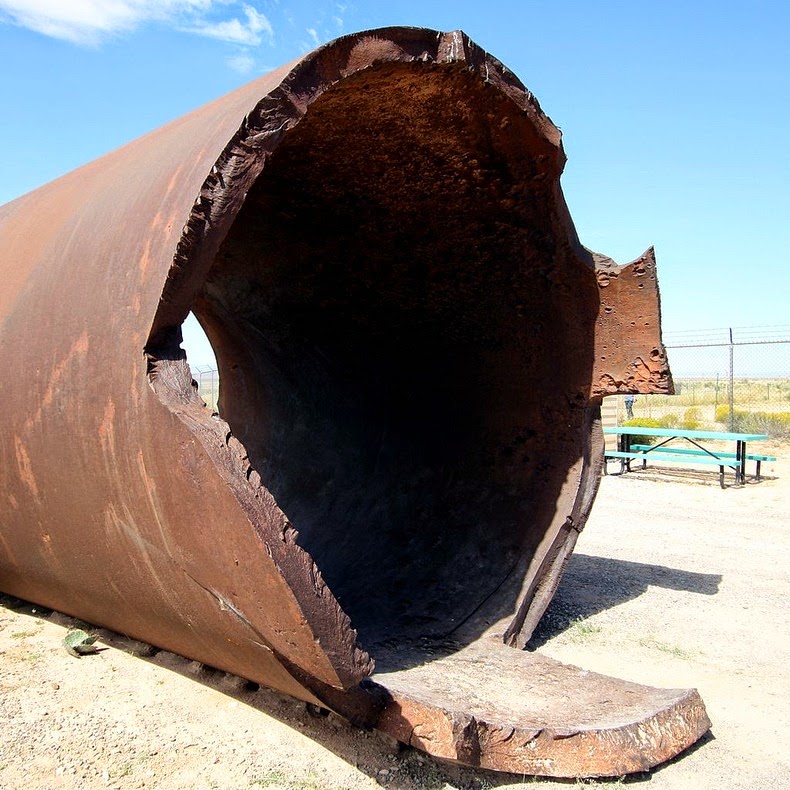On July 16, 1945, the world’s first nuclear explosion, code named Trinity, occurred at a test site located 336 km south of Los Alamos on the barren plains known as the Jornada del Muerto in New Mexico. The plutonium device, called the Gadget, was hoisted atop a 100-foot tower and detonated at precisely 5:30 am releasing energy equivalent to 18.6 kilotons of TNT, instantly vaporizing the tower and fusing the desert sand into green glass. The shock wave was felt over 160 km away, and windows still rattled 320 km away. The success of the Trinity test meant that an atomic bomb could be readied for use by the U.S. military. The first deployment occurred on August 6, 1945, when the Uranium-235 device was dropped on Hiroshima, Japan, and the rest is history.
Today, the Trinity Site is open to public only twice a year, on the first Saturday of April and October. Each time thousands of people make a pilgrimage to check out the partially filled crater left by history’s first atom bomb test – a slight depression measuring 340 feet across. At the center, a stone obelisk made of black lava rock marks ground zero, where the bomb was detonated.
The landmark includes the remnants of the base camp where some 250 scientists, soldiers, and technicians holed up to watch the detonation about 9 km away ground zero. Remnants of the observation points 10,000 yards out are also still visible. Only a few pieces of the green glass, which was named trinitite and still highly radioactive, remain in a protected enclosure. Outside the fenced-in ground zero area lies Jumbo, the 214-ton steel container built to contain the plutonium if the 5,300 pounds of high explosives in the bomb detonated but no nuclear explosion resulted. Jumbo was not used. There is also a restored McDonald ranch house, where the device's plutonium core was assembled.
More than sixty years after the test, residual radiation at the site is about ten times higher than earth’s background radiation and is generally harmless. Staying there for one hour exposes you to radiation that is less than the radiation received on an average day from natural and medical sources.
After being closed to the public for many years, the Trinity site was declared a National Historic Landmark district in 1965. The Trinity site is currently opened to the public by the National Park Service twice a year.
The 12-foot tall obelisk marks ground zero. Photo credit

The remnants of Jumbo, a large 214 tons steel container whose remnants lie in Trinity Site's parking lot. Photo credit
The heat of the explosion fused sand into green colored glass beads which were named trinitite. Photo credit
The famous color photograph of the "Trinity" shot, the first nuclear test explosion. Photo credit
The Trinity Site explosion, 0.016 second after explosion. Photo credit
The tower with "the gadget" used in the Trinity test, 1945. Photo credit
Sources: Wikipedia / Energy.gov



















What a sad time in American history. The creation of nuclear weapons, while a great technical achievement, is not something to be proud of.
ReplyDeleteLook at us, we can kill more innocent civilians this way. USA!
It's debatable whether or not the atomic bomb was necessary to end WWII. But what other kind of interpretation could we expect from a knuckle-dragging conservo-tard like yourself? And, since you are such a history genius you may recall that we chose not to drop the bomb on the Germans - racist much? "We have genuflected before the god of science only to find that it has given us the atomic bomb, producing fears and anxieties that science can never mitigate." Guess who said that, boo-boo? Martin Luther King Jr. So take your belligerent, ignorant opinions (not fax, f-head) and go nuke yourself.
ReplyDeleteGermany actually surrendered on May 2, 1945. The first test at Trinity site was scheduled for May 5, 1945, but delayed for two days until May 7, the last day of the European war. The first bomb used in war was dropped on Hiroshima on August 6, 1945. With the first test not occuring until five days after Germany surrendered, there was no need to use the bomb in Europe.
DeleteIt is perhaps debatable whether the atomic bomb was necessary to end WWII, but scientists of European background working on the Manhattan project were convinced that Hitler, if not Japan, was working on its own atomic bomb. Better safe than sorry.
Someone got schooled on the false narrative about not using the bomb against Germany...get your facts separated from your ideologies.
ReplyDelete